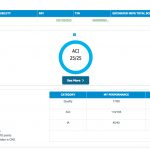Implementation of the Medicare Access and Chip Reauthorization Act of 2015 (MACRA) began Jan. 1. What does this mean for rheumatologists? It means you must pick the measures by which you will be evaluated and the pace at which you will begin reporting in the Merit-Based Incentive Payment System or participating in an Advanced Alternative Payment Model. [Also see “Quality Update Reporting Changes under MACRA.]”
The CMS has heavily incentivized participation in a Qualified Clinical Data Registry (QCDR), such as the Rheumatology Informatics System for Effectiveness (RISE) Registry, for reporting in MIPS. We will discuss the provider advantages to and bonuses for using RISE that some other physicians—who users will compete against—will not receive.
The MIPS Composite Score
Under MACRA, the quality of care you provide will be calculated by the MIPS Composite Score. Because this law is budget neutral, there must be winners and losers. To do this, the CMS will determine the average score of all providers; anyone above that score will receive bonuses, and anyone below will receive a penalty. The various degrees of bonuses and penalties are determined by how many standard deviations you are away from the CMS-determined average.
The MIPS Composite Score comprises four categories:
- Quality (replaces Physician Quality Reporting System [PQRS]): 50%
- Clinical Practices Improvement Activities (CPIAs) (new category): 15%
- Advancing Care Information (ACI) (replaces Meaningful Use): 25%
- Cost (replaces the Value-Based Modifier): 10%
Let’s take a closer look at each of the categories and how RISE can help improve your scores.
Quality
Because 2017 is a transition year, providers will participate in only three of the four MIPS categories, with the 10% coming from the Cost category shifting to the Quality category. But this is for only one year. Under MIPS, practices will report on six quality measures (three less than those under the old PQRS system), one of which must be an outcome measure (one less than PQRS) or a high-priority measure.
The CMS has established sets of specialty measures that providers are to pick from when reporting quality measures for MIPS. But because RISE is a QCDR, the ACR picks the measure set on which rheumatologists can report. The ACR has selected 16 measures, one of which is an outcome measure and five of which are high-priority measures. Click here to review RISE’s 2017 Quality Measures.
Clinical Practice Improvement Activities
CPIAs, a new category created under MIPS, comprise 90 activities. Practices need to obtain 40 points, with the activities weighted differently. Under CPIA, activities are weighted as medium (10 points) or high (20 points). Providers will have to attest that they have completed these activities for a minimum of 90 days.
Participation in a QCDR, such as RISE, allows you to collect 30 points immediately through two population management activities:
- Use of a QCDR to generate regular performance feedback that summarizes local practice patterns and treatment outcomes, including those of vulnerable populations. Weight (high): 20 points.
- Participation in a QCDR; clinical data registry; or other registry run by government agencies, such as the FDA, or private entities, such as a hospital or medical or surgical society; and using the data for quality improvement (e.g., comparative analysis across specific patient populations for adverse outcomes after an outpatient surgical procedure and corrective steps to address an adverse outcome). Weight (medium): 10 points.
For a full list of CPIAs, visit the CMS website.
Advancing Care Information
Satisfying ACI requirements will largely depend on the individual practice’s EHR system.
You must complete one of two options for ACI: 1) ACI Objectives and Measures or 2) 2017 ACI Transition Objectives and Measures. The length of time that your practice engaged in Meaningful Use will determine which of the two pathways you will take to satisfy this category.
You can report the ACI Objectives and Measures if you have:
- Technology certified to the 2015 edition; or
- A combination of technologies from the 2014 and 2015 editions that support these measures.
You can report the 2017 ACI Transition Objectives and Measures if you have:
- Technology certified to the 2015 edition;
- Technology certified to the 2014 edition; or
- A combination of technologies from 2014 and 2015 editions.
By participating in a QCDR, such as RISE, you are eligible for a 5% bonus in this category.
If you need help identifying your EHR edition or you would like to learn more about this category, follow this link.
Pick Your Pace for 2017
The final rule for MACRA calls for a transition year so that providers may become accustomed to the new payment program. There are four options that rheumatologists can pick from to begin the transition into MIPS:
- Non-Participation: This results in a 4% negative payment adjustment.
- Test Data Submission: Providers will avoid a negative payment adjustment, but will not be eligible for a bonus. This also requires one measure on one patient for one visit, or you can submit one improvement activity.
- Partial Data Submission: Submit 90 days of data, and you may earn a neutral or positive payment adjustment. For partial reporting, you must submit the required data for all three required categories in 2017:
(a) Quality: Six measures, including an outcome/high-priority measure;
(b) ACI: Four to five measures, depending on the option applicable to your EHR; and
(c) Clinical Practice Improvement Activities: Providers may choose two highly weighted or four medium-weighted activities. - Full Data Submission: Submit a full year of 2017 data to Medicare, and you may earn a positive payment adjustment. The reporting requirements are the same as for partial data submission (3a–c above), but for the entire year.
Want to Learn More?
If you are interested in joining RISE or have questions about the payment program in 2017, contact ACR staff at [email protected]. If you would like to learn more about the new Quality Payment Program, visit the Quality Payment Program information section on the CMS’s website.


